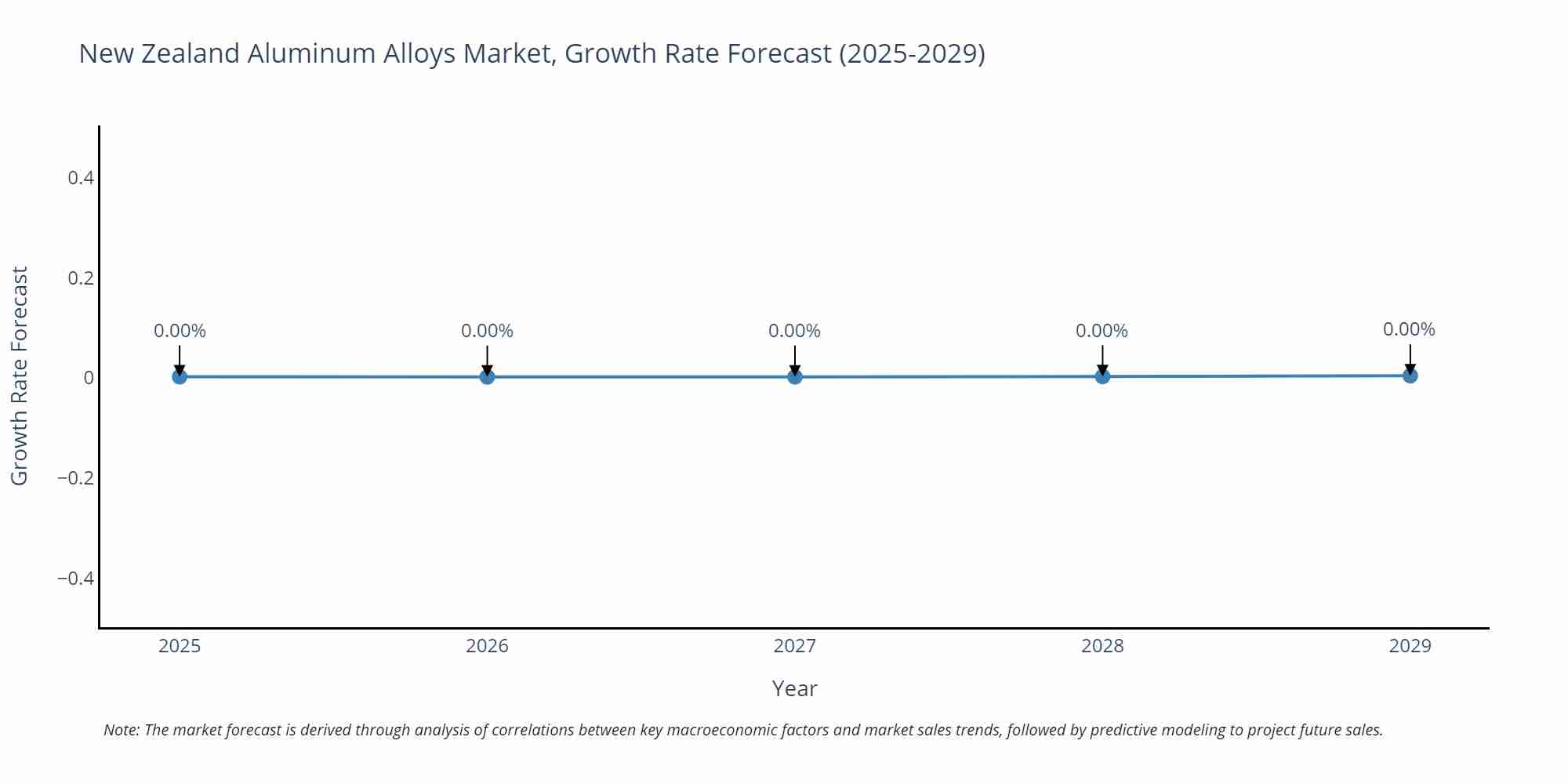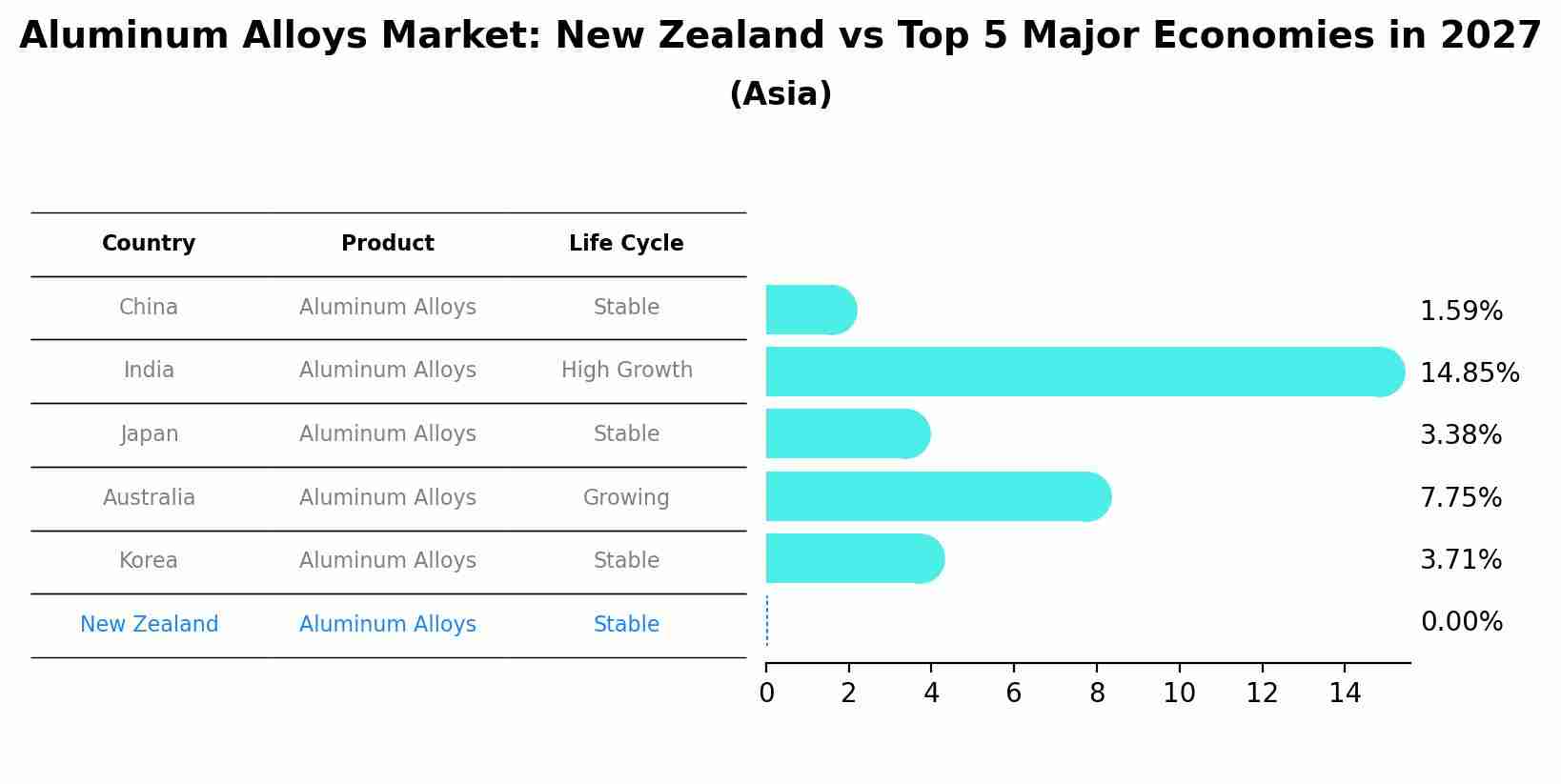New Zealand Aluminum Alloys Market (2025-2031) | Trends, Outlook, Segmentation, Share, Forecast, Industry, Size, Revenue, Value, Companies, Growth & Analysis
| Product Code: ETC5089988 | Publication Date: Nov 2023 | Updated Date: Sep 2025 | Product Type: Market Research Report | |
| Publisher: 6Wresearch | No. of Pages: 60 | No. of Figures: 30 | No. of Tables: 5 | |
New Zealand Aluminum Alloys Market Size Growth Rate
The New Zealand Aluminum Alloys Market is projected to witness mixed growth rate patterns during 2025 to 2029. The growth rate starts at 0.00% in 2025 and reaches 0.00% by 2029.

Aluminum Alloys Market: New Zealand vs Top 5 Major Economies in 2027 (Asia)
By 2027, the Aluminum Alloys market in New Zealand is anticipated to reach a growth rate of 0.00%, as part of an increasingly competitive Asia region, where China remains at the forefront, supported by India, Japan, Australia and South Korea, driving innovations and market adoption across sectors.

Key Highlights of the Report:
- New Zealand Aluminum Alloys Market Outlook
- Market Size of New Zealand Aluminum Alloys Market, 2024
- Forecast of New Zealand Aluminum Alloys Market, 2031
- Historical Data and Forecast of New Zealand Aluminum Alloys Revenues & Volume for the Period 2021-2031
- New Zealand Aluminum Alloys Market Trend Evolution
- New Zealand Aluminum Alloys Market Drivers and Challenges
- New Zealand Aluminum Alloys Price Trends
- New Zealand Aluminum Alloys Porter`s Five Forces
- New Zealand Aluminum Alloys Industry Life Cycle
- Historical Data and Forecast of New Zealand Aluminum Alloys Market Revenues & Volume By Process for the Period 2021-2031
- Historical Data and Forecast of New Zealand Aluminum Alloys Market Revenues & Volume By Die Casting for the Period 2021-2031
- Historical Data and Forecast of New Zealand Aluminum Alloys Market Revenues & Volume By Sand Casting for the Period 2021-2031
- Historical Data and Forecast of New Zealand Aluminum Alloys Market Revenues & Volume By Permanent Mold Casting for the Period 2021-2031
- Historical Data and Forecast of New Zealand Aluminum Alloys Market Revenues & Volume By End-use for the Period 2021-2031
- Historical Data and Forecast of New Zealand Aluminum Alloys Market Revenues & Volume By Transportation sector for the Period 2021-2031
- Historical Data and Forecast of New Zealand Aluminum Alloys Market Revenues & Volume By Building & Construction sector for the Period 2021-2031
- Historical Data and Forecast of New Zealand Aluminum Alloys Market Revenues & Volume By Industrial sector for the Period 2021-2031
- Historical Data and Forecast of New Zealand Aluminum Alloys Market Revenues & Volume By Others for the Period 2021-2031
- New Zealand Aluminum Alloys Import Export Trade Statistics
- Market Opportunity Assessment By Process
- Market Opportunity Assessment By End-use
- New Zealand Aluminum Alloys Top Companies Market Share
- New Zealand Aluminum Alloys Competitive Benchmarking By Technical and Operational Parameters
- New Zealand Aluminum Alloys Company Profiles
- New Zealand Aluminum Alloys Key Strategic Recommendations
Frequently Asked Questions About the Market Study (FAQs):
1 Executive Summary |
2 Introduction |
2.1 Key Highlights of the Report |
2.2 Report Description |
2.3 Market Scope & Segmentation |
2.4 Research Methodology |
2.5 Assumptions |
3 New Zealand Aluminum Alloys Market Overview |
3.1 New Zealand Country Macro Economic Indicators |
3.2 New Zealand Aluminum Alloys Market Revenues & Volume, 2021 & 2031F |
3.3 New Zealand Aluminum Alloys Market - Industry Life Cycle |
3.4 New Zealand Aluminum Alloys Market - Porter's Five Forces |
3.5 New Zealand Aluminum Alloys Market Revenues & Volume Share, By Process, 2021 & 2031F |
3.6 New Zealand Aluminum Alloys Market Revenues & Volume Share, By End-use, 2021 & 2031F |
4 New Zealand Aluminum Alloys Market Dynamics |
4.1 Impact Analysis |
4.2 Market Drivers |
4.2.1 Increasing demand for lightweight and durable materials in the automotive and aerospace industries |
4.2.2 Growing construction activities and infrastructure development in New Zealand |
4.2.3 Rising focus on sustainable and eco-friendly materials, driving the adoption of aluminum alloys |
4.3 Market Restraints |
4.3.1 Fluctuating prices of raw materials impacting the overall production costs |
4.3.2 Intense competition from alternative materials such as steel and composites |
4.3.3 Regulatory challenges and compliance requirements affecting the market growth |
5 New Zealand Aluminum Alloys Market Trends |
6 New Zealand Aluminum Alloys Market Segmentations |
6.1 New Zealand Aluminum Alloys Market, By Process |
6.1.1 Overview and Analysis |
6.1.2 New Zealand Aluminum Alloys Market Revenues & Volume, By Die Casting, 2021-2031F |
6.1.3 New Zealand Aluminum Alloys Market Revenues & Volume, By Sand Casting, 2021-2031F |
6.1.4 New Zealand Aluminum Alloys Market Revenues & Volume, By Permanent Mold Casting, 2021-2031F |
6.2 New Zealand Aluminum Alloys Market, By End-use |
6.2.1 Overview and Analysis |
6.2.2 New Zealand Aluminum Alloys Market Revenues & Volume, By Transportation sector, 2021-2031F |
6.2.3 New Zealand Aluminum Alloys Market Revenues & Volume, By Building & Construction sector, 2021-2031F |
6.2.4 New Zealand Aluminum Alloys Market Revenues & Volume, By Industrial sector, 2021-2031F |
6.2.5 New Zealand Aluminum Alloys Market Revenues & Volume, By Others, 2021-2031F |
7 New Zealand Aluminum Alloys Market Import-Export Trade Statistics |
7.1 New Zealand Aluminum Alloys Market Export to Major Countries |
7.2 New Zealand Aluminum Alloys Market Imports from Major Countries |
8 New Zealand Aluminum Alloys Market Key Performance Indicators |
8.1 Average selling price of aluminum alloys in New Zealand |
8.2 Percentage of aluminum alloys used in automotive manufacturing in New Zealand |
8.3 Number of infrastructure projects utilizing aluminum alloys in construction sector |
9 New Zealand Aluminum Alloys Market - Opportunity Assessment |
9.1 New Zealand Aluminum Alloys Market Opportunity Assessment, By Process, 2021 & 2031F |
9.2 New Zealand Aluminum Alloys Market Opportunity Assessment, By End-use, 2021 & 2031F |
10 New Zealand Aluminum Alloys Market - Competitive Landscape |
10.1 New Zealand Aluminum Alloys Market Revenue Share, By Companies, 2024 |
10.2 New Zealand Aluminum Alloys Market Competitive Benchmarking, By Operating and Technical Parameters |
11 Company Profiles |
12 Recommendations | 13 Disclaimer |
- Single User License$ 1,995
- Department License$ 2,400
- Site License$ 3,120
- Global License$ 3,795
Search
Related Reports
- ASEAN Bearings Market (2025-2031) | Strategy, Consumer Insights, Analysis, Investment Trends, Opportunities, Growth, Size, Share, Industry, Revenue, Segments, Value, Segmentation, Supply, Forecast, Restraints, Outlook, Competition, Drivers, Trends, Demand, Pricing Analysis, Competitive, Strategic Insights, Companies, Challenges
- Europe Flooring Market (2025-2031) | Outlook, Share, Industry, Trends, Forecast, Companies, Revenue, Size, Analysis, Growth & Value
- Saudi Arabia Manlift Market (2025-2031) | Outlook, Size, Growth, Trends, Companies, Industry, Revenue, Value, Share, Forecast & Analysis
- Uganda Excavator, Crane, and Wheel Loaders Market (2025-2031) | Strategy, Consumer Insights, Analysis, Investment Trends, Opportunities, Growth, Size, Share, Industry, Revenue, Segments, Value, Segmentation, Supply, Forecast, Restraints, Outlook, Competition, Drivers, Trends, Demand, Pricing Analysis, Competitive, Strategic Insights, Companies, Challenges
- Rwanda Excavator, Crane, and Wheel Loaders Market (2025-2031) | Strategy, Consumer Insights, Analysis, Investment Trends, Opportunities, Growth, Size, Share, Industry, Revenue, Segments, Value, Segmentation, Supply, Forecast, Restraints, Outlook, Competition, Drivers, Trends, Demand, Pricing Analysis, Competitive, Strategic Insights, Companies, Challenges
- Kenya Excavator, Crane, and Wheel Loaders Market (2025-2031) | Strategy, Consumer Insights, Analysis, Investment Trends, Opportunities, Growth, Size, Share, Industry, Revenue, Segments, Value, Segmentation, Supply, Forecast, Restraints, Outlook, Competition, Drivers, Trends, Demand, Pricing Analysis, Competitive, Strategic Insights, Companies, Challenges
- Angola Excavator, Crane, and Wheel Loaders Market (2025-2031) | Strategy, Consumer Insights, Analysis, Investment Trends, Opportunities, Growth, Size, Share, Industry, Revenue, Segments, Value, Segmentation, Supply, Forecast, Restraints, Outlook, Competition, Drivers, Trends, Demand, Pricing Analysis, Competitive, Strategic Insights, Companies, Challenges
- Israel Intelligent Transport System Market (2025-2031) | Strategy, Consumer Insights, Analysis, Investment Trends, Opportunities, Growth, Size, Share, Industry, Revenue, Segments, Value, Segmentation, Supply, Forecast, Restraints, Outlook, Competition, Drivers, Trends, Demand, Pricing Analysis, Competitive, Strategic Insights, Companies, Challenges
- Uganda Precast and Aggregate Market (2025-2031) | Strategy, Consumer Insights, Analysis, Investment Trends, Opportunities, Growth, Size, Share, Industry, Revenue, Segments, Value, Segmentation, Supply, Forecast, Restraints, Outlook, Competition, Drivers, Trends, Demand, Pricing Analysis, Competitive, Strategic Insights, Companies, Challenges
- Australia IT Asset Disposal Market (2025-2031) | Strategy, Consumer Insights, Analysis, Investment Trends, Opportunities, Growth, Size, Share, Industry, Revenue, Segments, Value, Segmentation, Supply, Forecast, Restraints, Outlook, Competition, Drivers, Trends, Demand, Pricing Analysis, Competitive, Strategic Insights, Companies, Challenges
Industry Events and Analyst Meet
Our Clients
Whitepaper
- Middle East & Africa Commercial Security Market Click here to view more.
- Middle East & Africa Fire Safety Systems & Equipment Market Click here to view more.
- GCC Drone Market Click here to view more.
- Middle East Lighting Fixture Market Click here to view more.
- GCC Physical & Perimeter Security Market Click here to view more.
6WResearch In News
- Doha a strategic location for EV manufacturing hub: IPA Qatar
- Demand for luxury TVs surging in the GCC, says Samsung
- Empowering Growth: The Thriving Journey of Bangladesh’s Cable Industry
- Demand for luxury TVs surging in the GCC, says Samsung
- Video call with a traditional healer? Once unthinkable, it’s now common in South Africa
- Intelligent Buildings To Smooth GCC’s Path To Net Zero













